
Aloha Airlines
TIMETABLES
Aloha Airlines
(AQ) The island state of Hawaii has always been a difficult region to
travel both to and from due to its remote nature in the Pacific Ocean.
Travel within the eight “major” islands was equally difficult with travel
between the various island towns and communities relying on boats or
ships. The advent of air travel opened Hawaii to a new, faster form of
transportation resulting in an increase in tourism, trade, and local
business.
Utilizing a single war-surplus Douglas DC-3 (A
C-47A originally delivered to the US Air Force),
Trans-Pacific Airways (TPA) was formed in 1946 to fly both passengers
and cargo between the islands of Oahu, Maui and Hawaii. The first
charter services started on July 26, 1946, and the hospitality of the
islands was quickly evident with complimentary pineapple juice being
served as well as “live” music from a ukulele. TPA was given permission
to start scheduled passenger service in February 1949, and won a US
Postal mail contract in 1951, the start of scheduled service put the
airline in direct competition to pioneering Intra-Island Airways, later
to become Hawaiian Airlines.
In 1957, the airlines name was officially
changed to Aloha Airlines and in an effort to better compete with
Hawaiian Airlines, an order was placed for the Fairchild F-27
turboprop, bringing “Jet-Prop” service to the islands. The new F-27s
destined for Aloha were almost custom built for the airline having
increased keel strength and underbody skin to satisfy the requirements
of a possible water ditching. The first F-27 was delivered on April 15,
1959, the same year that Hawaii became a state, and were immediately
popular with passengers resulting in Aloha taking a 40% share in the
intra-island market.
As Aloha continued to expand, the airline placed
into service the four-engine Vickers Viscount in 1963, to replace the
Fairchild F-27 aircraft, however the British made airplane had limitations
in the typically humid Pacific environment. As the “Jet” age had entered
the world of aviation, Aloha looked to introduce pure jet service to the
islands and placed an order for the new British Aerospace BAC-1-11
Twin-Jet. Three planes were ordered, each with a passenger capacity of
sixty-nine seats and the first being delivered to the airlines on April
15, 1966. Flights were started with the BAC-11-1 “AlohaJet” on April 27,
1966 between Honolulu, Hilo, Kauai, Kona, and Maui. It was soon realized
that the BAC-1-11 suffered the same restrictions as the Viscount and had
performance restrictions especially operating from Kona Airport. Facing
increased competition from Hawaiian Airlines using the new Douglas DC-9
airplane, Aloha looked to Boeing to solve its “jet” problems and placed
an order for two Boeing 737-200 airplanes in 1968. The first plane,
dubbed “Funbirds” was delivered in February 1969, and sported a new
corporate image of tropical yellow and orange with a colorful tail of
shaded abstract flowers. With the introduction of the new 737s, the
three BAC-1-11 were withdrawn from service by April 1969. Although the
introduction of the new Boeing’s helped the image, excess capacity, and
service delays from mainland carriers that would boost tourism were not
realized and Aloha suffered financially. Both Hawaiian Airlines and
Aloha Airlines were suffering and the idea of a merger between the two
carriers was courted.
Hawaiian backed out of the merger talks with the
thoughts that Aloha would continue to suffer and eventually file
bankruptcy yet the airline started off strong in early 1970s. As tourism
increased, the airline signed interline agreements with major carriers
to provide seamless intra-island service to their passengers.
Traditionally Aloha had only one competitor in the intra-island market;
Hawaiian Airlines, however this changed after deregulation in 1978. New
airline, Mid-Pacific Airlines entered the intra-island market with cheap
fares and frequent flights which cut into Alohas’ market share resulting
in another yearly loss to the airline.
Hoping to cash in on the deregulated market and
improve operations, Aloha started a division of the company called Aloha
Pacific in 1984, which started service on May 28, 1984, to Taipei,
Taiwan, via Guam using a leased Douglas DC-10. The service only lasted
until January 1985, due to fierce completion with established carrier
Continental Airlines in that specific market. Aloha Airlines placed into service
a “Quick-Change” variety of the Boeing 737 utilizing the aircraft at
night to promote intra-island only cargo services. In February 1986,
Aloha extended its wings beyond its Hawaiian borders and started
once-weekly service to Kiritimati (Christmas Island), 1,350 miles to the
south. This new service used an ETOPS rated Boeing 737-200, with Aloha
being the first airline to utilize the over-water option on the Boeing 737.
Aloha Airlines made world-wide news on April 28, 1988, when one of its
Boeing 737s operating a service from Hilo to Honolulu, suffered a
failure of the forward section roof, resulting in the death of a flight
attendant. After subsequent investigations it was determined that
corrosion and fatigue resulted in the failure of the roof section and it
set up new inspection requirements for utilization of older aircraft.
Throughout the 1990s, Aloha Airlines realized a rather strong operations
focusing on both its intra-island markets as well as it growing cargo
services. The airline introduced a new color scheme in 1992, using the
bold color of navy blue with the tail adorning a multi-colored Bird-of-Paradise flower (originally
used in their logo in the late 1960s) and a "guava" colored script of
“Aloha”
across the front fuselage.
In an effort to further solidify its position, Aloha took the bold step
in 1999, of leasing two, new Boeing 737-700 airplanes with a capacity of
123-passengers and starting mainland service to the United States. The
long-range -700 series was ETOPS certified and would allow the island
limited airline an opportunity to start service to “secondary” markets
along the West Coast. History was made for the airline on February 14,
2000, when non-stop service were started to Oakland from Honolulu,
marking the first time in the airlines fifty-four year history of
providing mainland services. This was also the first time the Boeing
737-700 airplane would be used in regular, trans-Pacific service to
Hawaii.
Aloha’s trans-Pacific mainland services were an instant hit with
passengers looking for a change from the major airports and traditional
airlines. With a further
delivery of three additional leased 737-700s, the airline increased
routes and cities where by September 2003, seven cities in the western
U.S. were being served as well as Vancouver, Canada. Non-stop Hawaii
flights were now being flown from Oakland, Burbank, and Orange County,
all in California with extension of services from Orange County and
Burbank, to Sacramento, Reno and Las Vegas, Nevada and Phoenix, Arizona.
Aloha Airlines had made a huge impact in the secondary niche market
along the West Coast, however a downturn in tourism, impact of the
September 11, 2001 terrorist attacks and rising fuel costs, the airline
filed for Chapter 11 bankruptcy protection on December 30, 2004. With a
fresh infusion of cash from new investors, a modified labor contract and
a new CEO, Aloha was able to emerge from Chapter 11 in February 2006.
Aloha’s future however remained bleak as competition from new
intra-island airline "Go!" as well as continue high fuel costs resulting
in the airline filing Chapter 11 bankruptcy again on March 20, 2008.
United Airlines had purchased a minority stake in the airline in May
2007, however the carrier continued losing money and wasn’t able to
secure additional funding resulting in Aloha Airlines suspended all
operations on March 31, 2008.
 Aloha Airlines
started operations as Trans-Pacific Airways (TPA) with a war surplus
C-47A to provide passenger charter service within the Hawaiian Islands.
Parked at the passenger terminal at Honolulu International Airport in
November 1958, is N2804D, a C-47A-DK, originally delivered to the US Air
Force in 1944, converted to a Douglas DC-3 and delivered to TPA in July
1956.
Aloha Airlines
started operations as Trans-Pacific Airways (TPA) with a war surplus
C-47A to provide passenger charter service within the Hawaiian Islands.
Parked at the passenger terminal at Honolulu International Airport in
November 1958, is N2804D, a C-47A-DK, originally delivered to the US Air
Force in 1944, converted to a Douglas DC-3 and delivered to TPA in July
1956.
.jpg) Aloha Airlines'
first "jet" aircraft was the Fairchild F-27 Turboprop, which replaced
the Douglas DC-3 and brought speed and comfort on intra-island routes.
Seen having freight loaded into its forward cargo compartment at Honolulu International
Airport in November 1960, is N5098A, a Fairchild F-27, delivered new to
Aloha Airlines in May 1960.
Aloha Airlines'
first "jet" aircraft was the Fairchild F-27 Turboprop, which replaced
the Douglas DC-3 and brought speed and comfort on intra-island routes.
Seen having freight loaded into its forward cargo compartment at Honolulu International
Airport in November 1960, is N5098A, a Fairchild F-27, delivered new to
Aloha Airlines in May 1960.
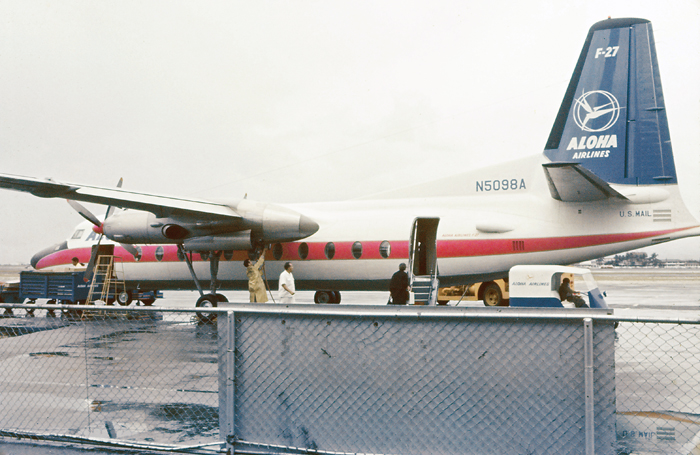 The Fairchild F-27
Turboprop was soon popular with passengers traveling between the
Hawaiian Islands. Seen being serviced during a turn-around at Honolulu
International Airport in October 1961, is N5098A, a Fairchild F-27,
delivered new to Aloha Airlines in May 1960.
The Fairchild F-27
Turboprop was soon popular with passengers traveling between the
Hawaiian Islands. Seen being serviced during a turn-around at Honolulu
International Airport in October 1961, is N5098A, a Fairchild F-27,
delivered new to Aloha Airlines in May 1960.
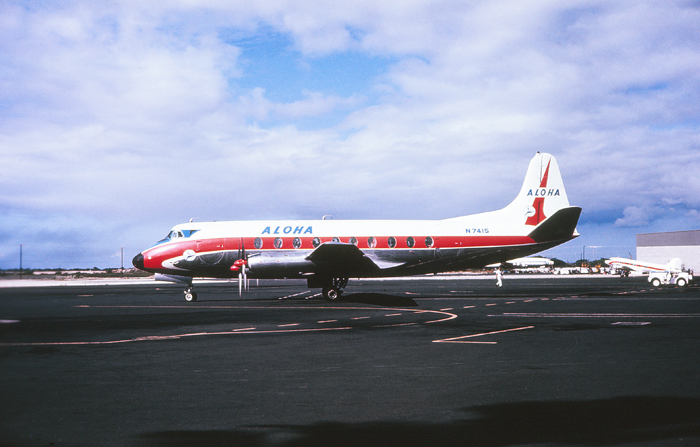 Ordered as a
replacement for the Fairchild F-27, the British made Vickers Viscount
was woefully inadequate for the tropical flying environment of the
Hawaiian Islands and were soon disposed of. Taxiing outbound for takeoff
at Honolulu International Airport in October 1964, is N7415 a Vickers
745D Viscount. This aircraft was subsequently written off after a ground
fire in Honolulu on August 8, 1971.
Ordered as a
replacement for the Fairchild F-27, the British made Vickers Viscount
was woefully inadequate for the tropical flying environment of the
Hawaiian Islands and were soon disposed of. Taxiing outbound for takeoff
at Honolulu International Airport in October 1964, is N7415 a Vickers
745D Viscount. This aircraft was subsequently written off after a ground
fire in Honolulu on August 8, 1971.
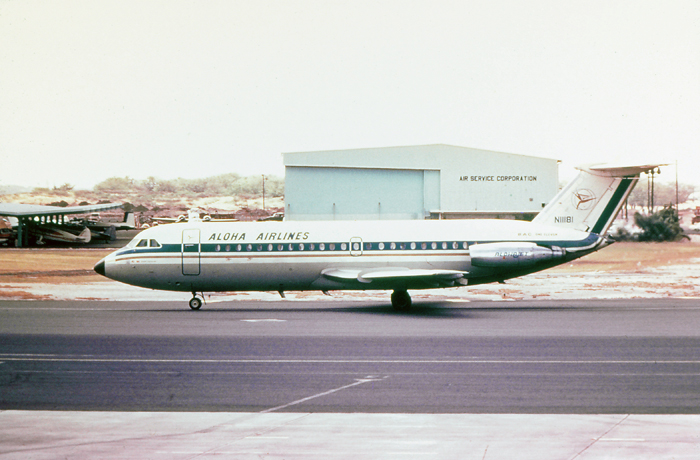 Aloha Airlines'
first pure jet aircraft was the British built BAC-1-11, dubbed the "AlohaJet."
The aircraft were only used for about three years before being replaced
with the Boeing 737. Seen taxiing outbound for takeoff at Honolulu
International Airport in August 1968, is N11181, a British Aerospace
BAC-1-11-215AU, delivered new to Aloha Airlines on April 15, 1966.
Aloha Airlines'
first pure jet aircraft was the British built BAC-1-11, dubbed the "AlohaJet."
The aircraft were only used for about three years before being replaced
with the Boeing 737. Seen taxiing outbound for takeoff at Honolulu
International Airport in August 1968, is N11181, a British Aerospace
BAC-1-11-215AU, delivered new to Aloha Airlines on April 15, 1966.
 Aloha Airlines
first Boeing 737 wearing the "Flower Power" color scheme introduced with
the delivery of the new plane. Seen loading passengers at Honolulu
International Airport in March 1969, is N571GB "King Lunalilo,"
a Boeing 737-2C0, delivered new to the airline on February 11, 1969.
Aloha Airlines
first Boeing 737 wearing the "Flower Power" color scheme introduced with
the delivery of the new plane. Seen loading passengers at Honolulu
International Airport in March 1969, is N571GB "King Lunalilo,"
a Boeing 737-2C0, delivered new to the airline on February 11, 1969.
.jpg) One of
Aloha Airlines new "Funbird," N73714, a Boeing 737-222 is parked at Kona
International Airport during a quick turn-around. Note the airline
titles at the rear of the fuselage an early experiment as frequently
passengers were loaded from the rear airstairs, however after a few
years the titles were moved to the more common forward location.
One of
Aloha Airlines new "Funbird," N73714, a Boeing 737-222 is parked at Kona
International Airport during a quick turn-around. Note the airline
titles at the rear of the fuselage an early experiment as frequently
passengers were loaded from the rear airstairs, however after a few
years the titles were moved to the more common forward location.
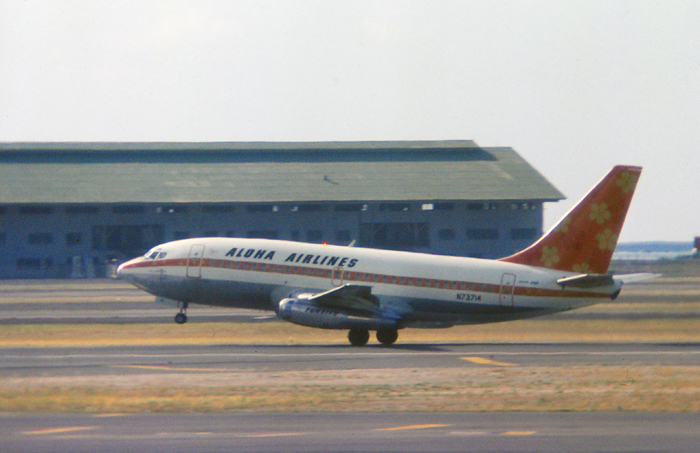 Rotating for
takeoff at Honolulu International Airport in 1973, and denoting the "Funbird"
titles on the engine nacelle is N73714, a Boeing 737-222, on lease from
United Airlines between 1971 and 1975.
Rotating for
takeoff at Honolulu International Airport in 1973, and denoting the "Funbird"
titles on the engine nacelle is N73714, a Boeing 737-222, on lease from
United Airlines between 1971 and 1975.
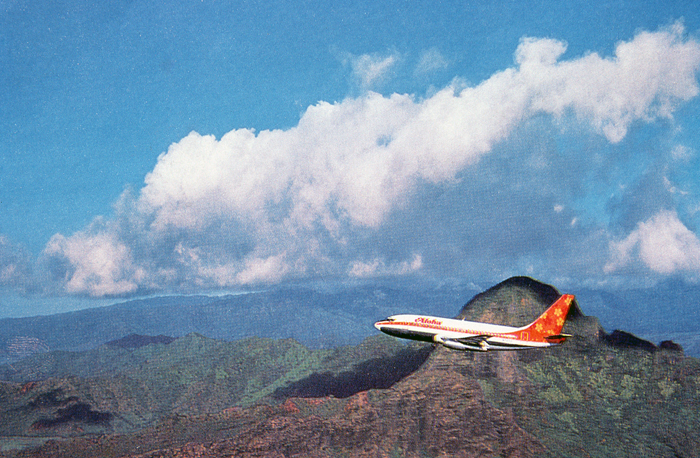 A
Boeing 737-200 shows off its "Flower Power" color scheme while flying
along the rugged tropical paradise of the Hawaiian Islands in this
promotional photo taken in February 1979.
A
Boeing 737-200 shows off its "Flower Power" color scheme while flying
along the rugged tropical paradise of the Hawaiian Islands in this
promotional photo taken in February 1979.
 The color scheme
that took Aloha Airlines through the 1970s was bright and colorful and
represented the warmth of the tropical island state of Hawaii. Parked at
the intra-island terminal and awaiting passengers at Honolulu
International Airport in September 1980, is N70721 "King Lunalilo,"
a Boeing 737-284, delivered new to Aloha in September 1977.
The color scheme
that took Aloha Airlines through the 1970s was bright and colorful and
represented the warmth of the tropical island state of Hawaii. Parked at
the intra-island terminal and awaiting passengers at Honolulu
International Airport in September 1980, is N70721 "King Lunalilo,"
a Boeing 737-284, delivered new to Aloha in September 1977.
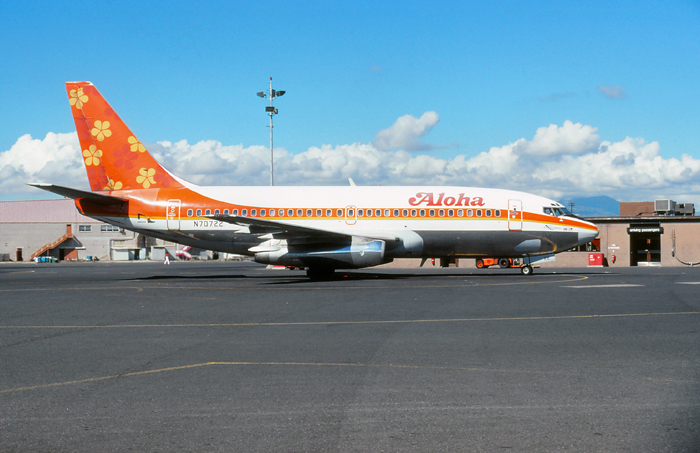 By 1981, Aloha
was operating ten Boeing 737-200s for services within Hawaii. Parked at
the intra-island terminal at Honolulu International Airport in December
1981, is N70722 "King Kaumualii," a Boeing 737-285(A),
delivered new to Aloha Airlines in August 1977.
By 1981, Aloha
was operating ten Boeing 737-200s for services within Hawaii. Parked at
the intra-island terminal at Honolulu International Airport in December
1981, is N70722 "King Kaumualii," a Boeing 737-285(A),
delivered new to Aloha Airlines in August 1977.
 A Boeing mock-up
model shows what the Aloha colors would look on the manufactures new
Boeing 757. Unfortunately, the airline's orders for three of the planes
were cancelled before planned service was to be started in 1983.
A Boeing mock-up
model shows what the Aloha colors would look on the manufactures new
Boeing 757. Unfortunately, the airline's orders for three of the planes
were cancelled before planned service was to be started in 1983.
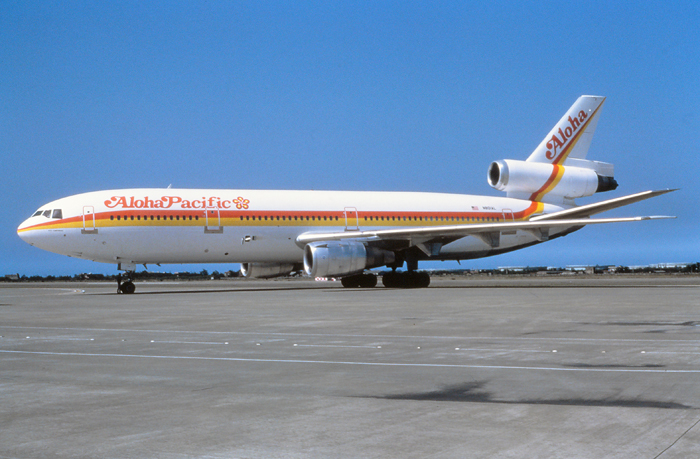 Aloha
Airlines attempted to enter the long-range market in 1984, with the
introduction of Honolulu-Guam-Taiwan flights under the Aloha Pacific
brand using a Douglas DC-10. The venture lasted only eight months citing
stiff competition from Continental Airlines. Preparing to depart the
ramp at Taipei International Airport in June 1984, is N801AL, a Douglas
DC-10-30 leased out from Philippine Airlines in May 1984.
Aloha
Airlines attempted to enter the long-range market in 1984, with the
introduction of Honolulu-Guam-Taiwan flights under the Aloha Pacific
brand using a Douglas DC-10. The venture lasted only eight months citing
stiff competition from Continental Airlines. Preparing to depart the
ramp at Taipei International Airport in June 1984, is N801AL, a Douglas
DC-10-30 leased out from Philippine Airlines in May 1984.
 Aloha Airlines
introduced a more subtle color scheme in 1984, which came with the
change of airline management with Joseph O' Gorman as the new CEO.
Having just pulled into its gate assignment at Honolulu International
Airport in November 1984, is N73717 "King Kalamikupule," a
Boeing 737-2H4, originally delivered to Southwest Airlines in June 1971,
and then leased by Aloha in July 1978.
Aloha Airlines
introduced a more subtle color scheme in 1984, which came with the
change of airline management with Joseph O' Gorman as the new CEO.
Having just pulled into its gate assignment at Honolulu International
Airport in November 1984, is N73717 "King Kalamikupule," a
Boeing 737-2H4, originally delivered to Southwest Airlines in June 1971,
and then leased by Aloha in July 1978.
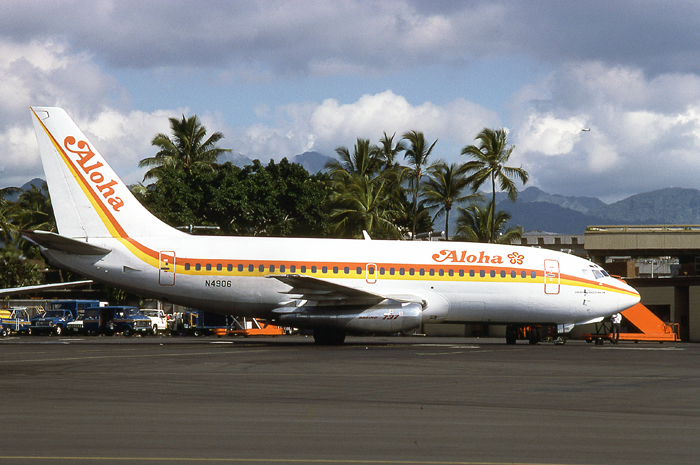 By 1987, Aloha
Airlines was flying over fifty daily departures from Honolulu to
intra-island destinations. Parked out the Outer Island Terminal at
Honolulu International Airport is N4906 "King Kaleleonalani," a Boeing 737-210C, originally
delivered to Wien Air Alaska in May 1969, and leased by Aloha between
August 1985 and October 1990.
By 1987, Aloha
Airlines was flying over fifty daily departures from Honolulu to
intra-island destinations. Parked out the Outer Island Terminal at
Honolulu International Airport is N4906 "King Kaleleonalani," a Boeing 737-210C, originally
delivered to Wien Air Alaska in May 1969, and leased by Aloha between
August 1985 and October 1990.
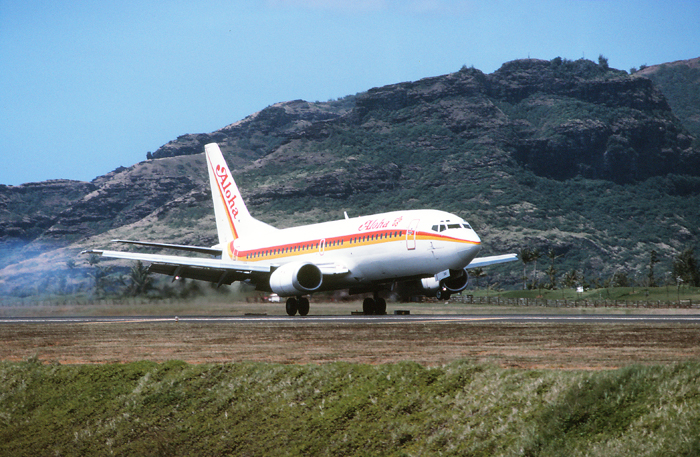 During 1988, Aloha
leased the Boeing 737-300 for more fuel efficient operations across its
network. Seen touching down on Runway 35 at Lihue Airport in May 1989,
is N301AL, a Boeing 737-3TO, delivered new to Aloha in June 1988.
During 1988, Aloha
leased the Boeing 737-300 for more fuel efficient operations across its
network. Seen touching down on Runway 35 at Lihue Airport in May 1989,
is N301AL, a Boeing 737-3TO, delivered new to Aloha in June 1988.
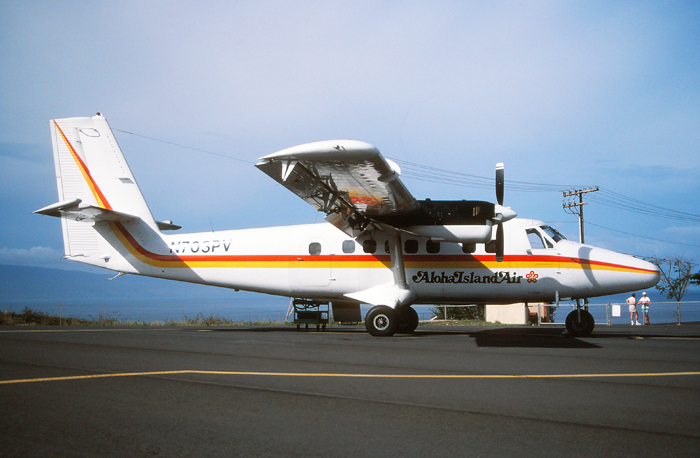 Aloha Island Air
was formed after the purchase of local commuter Princeville Airways to
provide service to the smaller communities of the various Hawaiian
Islands. Parked on the ramp at Kapalua Airport in January 1990, is
N703PV, a de Havilland DHC-6-300 Twin Otter, originally delivered to Key
Airlines in 1974, and taken up by Aloha Island with the purchase of
Princeville Airways in 1987.
Aloha Island Air
was formed after the purchase of local commuter Princeville Airways to
provide service to the smaller communities of the various Hawaiian
Islands. Parked on the ramp at Kapalua Airport in January 1990, is
N703PV, a de Havilland DHC-6-300 Twin Otter, originally delivered to Key
Airlines in 1974, and taken up by Aloha Island with the purchase of
Princeville Airways in 1987.
.jpg) Aloha
Airlines purchased many of its 737s on the secondary market allowing the
carrier a "deal" on its backbone aircraft. Seen taxiing outbound for a
departure at Honolulu International Airport in April 1991, is N801AL, a
Boeing 737-202C, originally delivered to Wien Consolidated Airlines in
1968, and leased by Aloha
in March 1986.
Aloha
Airlines purchased many of its 737s on the secondary market allowing the
carrier a "deal" on its backbone aircraft. Seen taxiing outbound for a
departure at Honolulu International Airport in April 1991, is N801AL, a
Boeing 737-202C, originally delivered to Wien Consolidated Airlines in
1968, and leased by Aloha
in March 1986.
 Aloha Island Air
chose a rather unique aircraft to start replacing the aging DHC-6 Twin
Otter fleet. The German made turboprop, the Dornier 228 had a capacity
of 19-passengers and had a high-wing characteristic important for
passengers to enjoy the beauty of the Hawaiian Islands. Parked on the
commuter ramp at Honolulu International Airport is N256MC, a Dornier
228-201.
Aloha Island Air
chose a rather unique aircraft to start replacing the aging DHC-6 Twin
Otter fleet. The German made turboprop, the Dornier 228 had a capacity
of 19-passengers and had a high-wing characteristic important for
passengers to enjoy the beauty of the Hawaiian Islands. Parked on the
commuter ramp at Honolulu International Airport is N256MC, a Dornier
228-201.
.jpg) The de
Havilland DHC-6 Twin Otter was a perfect aircraft to use on flights to
smaller island locations, with shorter field lengths, such as this
example of N701PV a de Havilland DHC-6-300 Twin otter taxiing away from
the terminal building at Hana Airport in September 1995.
The de
Havilland DHC-6 Twin Otter was a perfect aircraft to use on flights to
smaller island locations, with shorter field lengths, such as this
example of N701PV a de Havilland DHC-6-300 Twin otter taxiing away from
the terminal building at Hana Airport in September 1995.
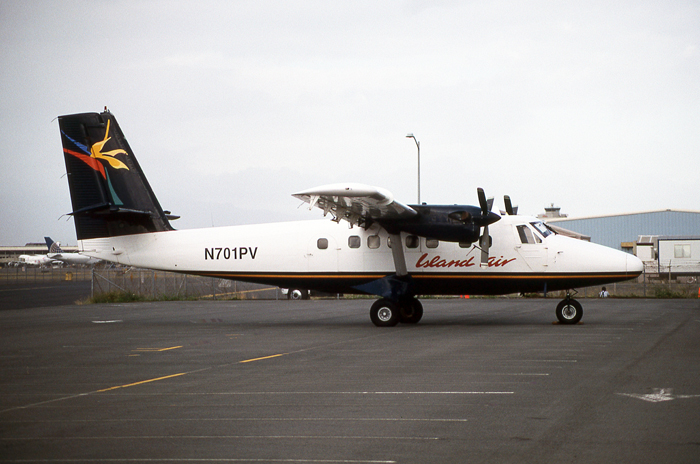 Wearing
just "Island Air" titles, N701PV, a de Havilland DHC-6-300 Twin
Otter is parked on the ramp at Honolulu International Airport
in January 1996.
Wearing
just "Island Air" titles, N701PV, a de Havilland DHC-6-300 Twin
Otter is parked on the ramp at Honolulu International Airport
in January 1996.
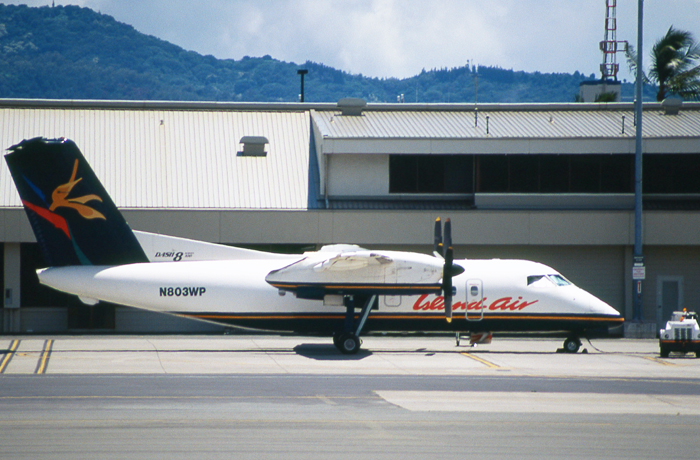 Aloha
Island Air took delivery of its first thirty-seven passenger
"Dash 8" turboprop in April 1995, to serve the growing commuter market
within the smaller island locations. Parked at the intra-island ramp
at Honolulu International Airport and awaiting passengers for another
flight in September 1997, is N803WP, a de Havilland DHC-8-103 "Dash
8," originally delivered to Air Atlantic in March 1989 and
purchased by Aloha in June 1996.
Aloha
Island Air took delivery of its first thirty-seven passenger
"Dash 8" turboprop in April 1995, to serve the growing commuter market
within the smaller island locations. Parked at the intra-island ramp
at Honolulu International Airport and awaiting passengers for another
flight in September 1997, is N803WP, a de Havilland DHC-8-103 "Dash
8," originally delivered to Air Atlantic in March 1989 and
purchased by Aloha in June 1996.
 To
commemorate the 1999 Aloha Festivals, Aloha Airlines decorated one its
aircraft with a flowered lei. Parked at the intra-island terminal in
February 2000, is N824AL "Kalaniopu'u,"
a Boeing 737-282, originally delivered to TAP-Air Portugal and bought by
Aloha in March 1998.
To
commemorate the 1999 Aloha Festivals, Aloha Airlines decorated one its
aircraft with a flowered lei. Parked at the intra-island terminal in
February 2000, is N824AL "Kalaniopu'u,"
a Boeing 737-282, originally delivered to TAP-Air Portugal and bought by
Aloha in March 1998.
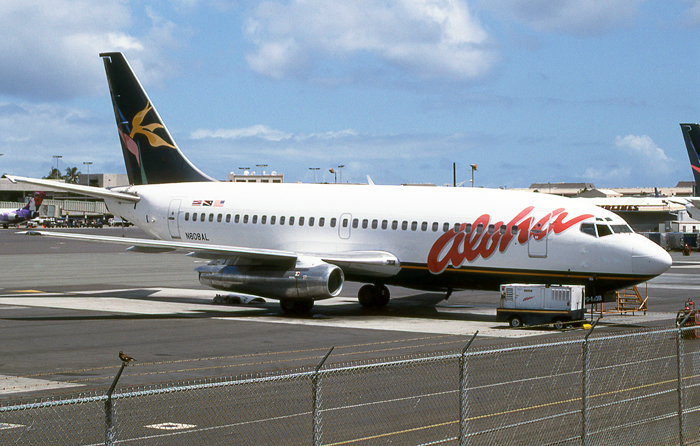 Aloha
Airlines was the first airline to get the Boeing 737 certified for
Extended Twin Overwater Passenger Service (ETOPS) in 1986, when it
started weekly flights to Kiritimati or Christmas Island. Eventually
Aloha would provide service to other remote Pacific destinations such as
Majuro, Kwajalein, Midway, and Pago Pago. Parked at the Aloha maintenance
stand at Honolulu International Airport is N808AL "Kaleleonalani,"
an ETOPS certified Boeing 737-2T4, leased to the airline in June 1994.
Note the Republic of the Marshall Islands flag on the rear fuselage next
to the US and State of Hawaii Flags.
Aloha
Airlines was the first airline to get the Boeing 737 certified for
Extended Twin Overwater Passenger Service (ETOPS) in 1986, when it
started weekly flights to Kiritimati or Christmas Island. Eventually
Aloha would provide service to other remote Pacific destinations such as
Majuro, Kwajalein, Midway, and Pago Pago. Parked at the Aloha maintenance
stand at Honolulu International Airport is N808AL "Kaleleonalani,"
an ETOPS certified Boeing 737-2T4, leased to the airline in June 1994.
Note the Republic of the Marshall Islands flag on the rear fuselage next
to the US and State of Hawaii Flags.
 Aloha
Airlines received its first ETOPS certified Boeing 737-700 series
airplane in January 2000, to provide services to the US Mainland from
the Hawaiian Islands. Having just been pushed back from the gate and
awaiting taxi clearance at Orange County-John Wayne Airport in September
2001, is N740AL "Kamohoali'i," a Boeing 737-76N, delivered new to Aloha
Airlines in march 2001.
Aloha
Airlines received its first ETOPS certified Boeing 737-700 series
airplane in January 2000, to provide services to the US Mainland from
the Hawaiian Islands. Having just been pushed back from the gate and
awaiting taxi clearance at Orange County-John Wayne Airport in September
2001, is N740AL "Kamohoali'i," a Boeing 737-76N, delivered new to Aloha
Airlines in march 2001.
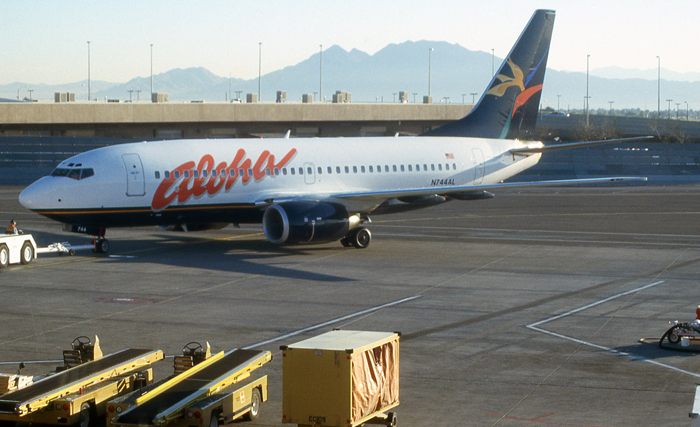 The
benefit of Aloha Airlines new ETOPS Boeing 737s, was expansion to
secondary markets along the U.S. West Coast, including many cities which
had no non-stop services to Hawaii. Seen being pushed back from the gate at Phoenix-Sky Harbor Airport for the short hop to Orange County-John Wayne Airport
then continuing to Honolulu in May 2003, is N744AL, a Boeing 737-76N, leased from GECAS in November
2001.
The
benefit of Aloha Airlines new ETOPS Boeing 737s, was expansion to
secondary markets along the U.S. West Coast, including many cities which
had no non-stop services to Hawaii. Seen being pushed back from the gate at Phoenix-Sky Harbor Airport for the short hop to Orange County-John Wayne Airport
then continuing to Honolulu in May 2003, is N744AL, a Boeing 737-76N, leased from GECAS in November
2001.
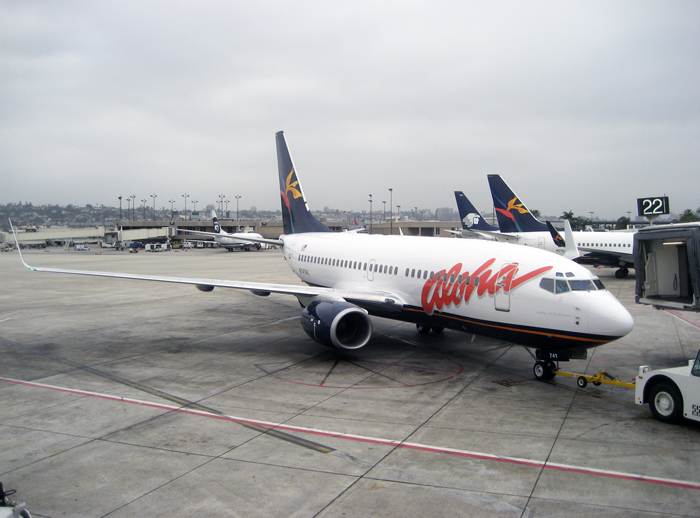 A
pair of Aloha 737-700s with blended winglets installed are seen at San Diego-Lindbergh Field just days
before the airline stopped operations in March 2008. Being pushed back
from the gate at the West Terminal for a morning departure to Honolulu
is N741AL "Olopana," a Boeing 737-76N, leased to Aloha Airlines in March 2001.
A
pair of Aloha 737-700s with blended winglets installed are seen at San Diego-Lindbergh Field just days
before the airline stopped operations in March 2008. Being pushed back
from the gate at the West Terminal for a morning departure to Honolulu
is N741AL "Olopana," a Boeing 737-76N, leased to Aloha Airlines in March 2001.